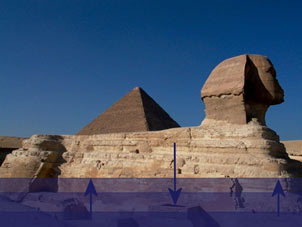The Great Pyramid of Giza as a monument of creation - Part 2: Water Element
Source: ancient-origins.net

The Sphinx is not a mythical creature from Egyptian mythology and no ’half man/half lion’, but a lying, guardian lion who was worshiped. At the time of the life-giving floods of the Nile, the Sun and the constellation of Leo came both above the horizon in the east, and therefore the Sphinx was called the ’Guardian of the Sun’. In the northern hemisphere the constellation Leo can be seen in the spring, the season that the rainy season starts in eastern Africa. This tropical monsoon climate in central and eastern Africa with its heavy rains is the most important water supplier of the Nile and this resulted in flooding in Egypt.
The Lion of Giza on the banks of the Nile welcomes the arrival of Hapi, the Egyptian god of the floods. The coming of the water is a fact and therefore the further process is put into action.
Through the flooded Nile at the height of Giza ’pure’ water was admitted to the Sphinx Temple and the so-called Sphinx Moat in which the Sphinx as a guardian of the plateau is placed (image 4). Besides clean, the water had to be pure. Pure water with a pure vibrational frequency cooks more quickly. The water had a completely natural way, without interference from outside, to find its way into the Sphinx Temple where it, through so called organic movements in the temple itself, was further purified before being admitted to the Sphinx Moat through an ingenious lock system. Intact water molecules with the appropriate pure energy as a raw material for the most natural and special ’House of Energy’ ever built.

Image 4. The Sphinx Moat filled with water from the Nile
Through wells on the sides of the body of the Sphinx, the water was further admitted to the underground reservoirs and tunnels, which are, located underneath the Giza plateau. Directly underneath the Sphinx is a water reservoir that forms an important part of the so-called Heron’s principle. This means that the water in a natural manner can be put under pressure, and can thus be driven up in the direction of the Great Pyramid. This is also known as ’Heron’s fountain’ and is used to pump up water to a higher level in a natural way (image 5).
Because the various pyramid complexes along the Nile were connected by an underground tunnel system it was quite easy to carry the water to the lower pyramids like the Great Pyramid of Giza. The Giza Plateau itself never flooded due to the high altitude, but it is known that the water of the river Nile, during the floods came to the front paws of the Sphinx (Herodotus 435 B.C.) through the appropriate location of the Sphinx Temple. The water of life from the Nile, equal to the power of the Sun, manifesting through the Sun god ’Ra’ or ’Re’ and destined for the complex of Giza. The pure water was used as raw material for the Great Pyramid. Through the subterranean chamber the water came into the Great Pyramid and through the pressure the excess water was led back through the descending passage to the outside of the pyramid. A special valve in the form of a hinged prism stone (image 6) and the completely closed pyramid ensured that a vacuum could emerge above the water surface remaining in the Great Pyramid after closing the water supply.

Image 5. Heron’s fountain
[...]
Read the full article at: ancient-origins.net
You can also find "The Great Pyramid of Giza as a monument of creation - Part 1: Earth", at Ancient Origins.
Tune into Red Ice Radio:
Robert Schoch - Hour 1 - The Mystery of the Sphinx
Christopher Dunn - The Hidden Chamber Behind Gantenbrink’s Door & The Giza Power Plant
Egypt Roundtable - Hour 1 - Ancient Technologies & Khemitology
Maria Wheatley - Hour 1 - Geodetic System of Earth Energies and Ley Lines
Ross Hamilton, Jim Vieira & Hugh Newman - Hour 1 - Giants, Mound Builders & Etheric Energy
John Anthony West & Laird Scranton - Göbekli Tepe






















